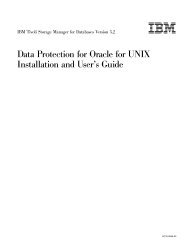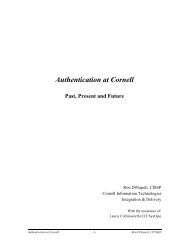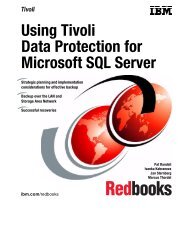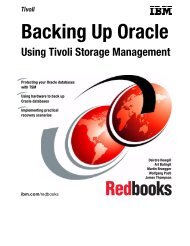Installation and User's Guide - Services and Support
Installation and User's Guide - Services and Support
Installation and User's Guide - Services and Support
You also want an ePaper? Increase the reach of your titles
YUMPU automatically turns print PDFs into web optimized ePapers that Google loves.
IBM Confidentialchanges. An example of this is the Tivoli Storage Manager server address, theschedule mode, or the client TCP address or port. This can be done by issuingthe following comm<strong>and</strong>s:net stop "Data Protection for Exchange Scheduler"net start "Data Protection for Exchange Scheduler"Note: IMPORTANT! If you are running the scheduler service in a clusterenvironment, use the Cluster Administrator to stop <strong>and</strong> restart your schedulerservice. Do NOT use the net stop <strong>and</strong> net start comm<strong>and</strong>s.v The default Tivoli Storage Manager scheduler log file (dsmsched.log) containsstatus information for the Tivoli Storage Manager scheduler. In this example, thefile is located in this path:d:\Program Files\Tivoli\TSM\TDPExchange\dsmsched.logYou can override this file name by specifying the schedlogname option in theData Protection for Exchange options file.v Data Protection for Exchange creates its own log file with statistics about thebacked up storage group objects when the /logfile parameter is specified duringthe tdpexcc comm<strong>and</strong>. In the sample file (excfull.smp), the log file isexcsched.log. This file is different from the Tivoli Storage Manager scheduler logfile <strong>and</strong> must also be different from the file to which the tdpexcc comm<strong>and</strong>output is redirected. In the example above, this file is excfull.log.Note: Output from scheduled comm<strong>and</strong>s are sent to the scheduler log file(dsmsched.log). After scheduled work is performed, check the log to ensure thework completed successfully.When a scheduled comm<strong>and</strong> is processed, the scheduler log might contain thefollowing entry:Scheduled event eventname completed successfullyThis is merely an indication that Tivoli Storage Manager successfully issued thescheduled comm<strong>and</strong> associated with the eventname. No attempt is made todetermine the success or failure of the comm<strong>and</strong>. You should assess the successor failure of the comm<strong>and</strong> by evaluating the return code from the scheduledcomm<strong>and</strong> in the scheduler log. The scheduler log entry for the comm<strong>and</strong>’sreturn code is prefaced with the following text:Finished comm<strong>and</strong>. Return code is:v If passwordaccess generate is not specified in the dsm.opt file, then the TivoliStorage Manager password needs to be specified on the tdpexcc comm<strong>and</strong>. Tospecify the password, use the /tsmpassword parameter in the comm<strong>and</strong> filebeing run by the scheduler (excfull.cmd). You can also specify the password onthe Data Protection for Exchange comm<strong>and</strong> line. For example:tdpexcc query tsm /tsmnode=mars1 /tsmpassword=newpasswordIf you plan to perform scheduled VSS operations in a cluster environment, beaware of these considerations:v Install the Tivoli Storage Manager scheduler as a Windows service on bothcluster nodes.v If the comm<strong>and</strong> file resides on a local drive, you must make sure that it remainsconsistent on all cluster nodes. Optionally, you can create the comm<strong>and</strong> file on ashared drive. Make sure the objects parameter (specified with the defineschedule comm<strong>and</strong> on the Tivoli Storage Manager server) points to thiscomm<strong>and</strong> file.Chapter 6. Using the Tivoli Storage Manager scheduler 121














